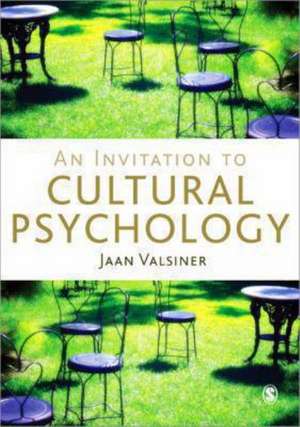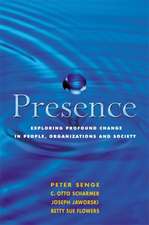An Invitation to Cultural Psychology
Autor Jaan Valsineren Limba Engleză Paperback – 20 iul 2014
Based on historical work from many different fields in the social and behavioural sciences, and the humanities too, this perspective applied to cultural psychology suggests that human beings are constantly creating, maintaining and abandoning hierarchies of meanings within all cultural contexts they experience. It’s a perspective that leans heavily on the work of the great French philosopher, Henri Bergson, only now being realised as a core basis for human cultural living.
Jaan Valsiner is the founding editor of the major journal in the field, Culture & Psychology, and Editor of the Oxford Handbook of Culture and Psychology. He is the first Niels Bohr Professor of Cultural Psychology at Aalborg University in Denmark, where he leads Europe's first Research Centre on Cultural Psychology.
| Toate formatele și edițiile | Preț | Express |
|---|---|---|
| Paperback (1) | 349.84 lei 3-5 săpt. | +25.30 lei 4-10 zile |
| SAGE Publications – 20 iul 2014 | 349.84 lei 3-5 săpt. | +25.30 lei 4-10 zile |
| Hardback (1) | 1089.08 lei 6-8 săpt. | |
| SAGE Publications – 20 iul 2014 | 1089.08 lei 6-8 săpt. |
Preț: 349.84 lei
Nou
Puncte Express: 525
Preț estimativ în valută:
66.96€ • 72.76$ • 56.29£
66.96€ • 72.76$ • 56.29£
Carte disponibilă
Livrare economică 31 martie-14 aprilie
Livrare express 14-20 martie pentru 35.29 lei
Preluare comenzi: 021 569.72.76
Specificații
ISBN-13: 9781446248782
ISBN-10: 144624878X
Pagini: 304
Ilustrații: black & white illustrations, figures
Dimensiuni: 170 x 242 x 17 mm
Greutate: 0.52 kg
Ediția:New.
Editura: SAGE Publications
Colecția Sage Publications Ltd
Locul publicării:London, United Kingdom
ISBN-10: 144624878X
Pagini: 304
Ilustrații: black & white illustrations, figures
Dimensiuni: 170 x 242 x 17 mm
Greutate: 0.52 kg
Ediția:New.
Editura: SAGE Publications
Colecția Sage Publications Ltd
Locul publicării:London, United Kingdom
Recenzii
An Invitation to Cultural Psychology is a fascinating and timely volume. It offers rich insights into the connections between personal subjective and social collective domains of human experience, demonstrating the importance of integrating these perspectives in cultural psychology for more nuanced approaches to the study of humans as individual and cultural actors.
From one of the great minds of our time, a bold and original essay on the nature of culture, putting in perspective semiotics and cultural psychology. Professor Valsiner provides a new approach of signs in action and grounds it in the best intellectual tradition. Deep, but written in easy language, refreshingly humorous for such an ambitious scholarly work and illustrated with good metaphors, simple graphics and many empirical examples.
This book is in the best sense of the word an invitation to cultural psychology. Jaan Valsiner provides analyses and insights based on a sound review of historical works in the social and behavioural sciences both explaining the current state of cultural psychology and outlining its future developments. Meaning and the dynamic construction of meaning in culture set the frame and core topics of this book which is itself an excellent and in so many ways a meaningful contribution to the field. Its a compelling must-read for anyone interested in cultural psychology.
Rather than review and expound on research conducted within the cultural psychology arena, Valsiner delves into the theoretical background and implications of culture in humans’ everyday lives. Utilizing various perspectives - e.g. psychology, sociology, history, anthropology, philosophy - the book is far from a traditional introductory resource on cultural psychology. The departure from mainstream psychology is evident from the first chapters, in which the author highlights the misadventures and missed opportunities of psychology to incorporate culture. Starting from the relatively simple notion that psyche and culture are mutually constituted, Valsiner explores the relationship through a variety of examples, such as signs, myths, art, place, objects, fashion, and so on. Although the book is at times dense with theory and philosophical explanations, Valsiner provides numerous examples from historical accounts and supplements theory with graphics to depict abstract concepts. Readers interested in the theoretical aspects of cultural psychology will find this book a useful guide.
The book by Valsiner is much more than an explication of how cultural interpretation may be created and co-constructed in social contexts. It is a powerful work, theoretical and well-documented, founding a new direction, aimed at deepening our understanding of the cultural psychology of semiotic dynamics.
From one of the great minds of our time, a bold and original essay on the nature of culture, putting in perspective semiotics and cultural psychology. Professor Valsiner provides a new approach of signs in action and grounds it in the best intellectual tradition. Deep, but written in easy language, refreshingly humorous for such an ambitious scholarly work and illustrated with good metaphors, simple graphics and many empirical examples.
This book is in the best sense of the word an invitation to cultural psychology. Jaan Valsiner provides analyses and insights based on a sound review of historical works in the social and behavioural sciences both explaining the current state of cultural psychology and outlining its future developments. Meaning and the dynamic construction of meaning in culture set the frame and core topics of this book which is itself an excellent and in so many ways a meaningful contribution to the field. Its a compelling must-read for anyone interested in cultural psychology.
Rather than review and expound on research conducted within the cultural psychology arena, Valsiner delves into the theoretical background and implications of culture in humans’ everyday lives. Utilizing various perspectives - e.g. psychology, sociology, history, anthropology, philosophy - the book is far from a traditional introductory resource on cultural psychology. The departure from mainstream psychology is evident from the first chapters, in which the author highlights the misadventures and missed opportunities of psychology to incorporate culture. Starting from the relatively simple notion that psyche and culture are mutually constituted, Valsiner explores the relationship through a variety of examples, such as signs, myths, art, place, objects, fashion, and so on. Although the book is at times dense with theory and philosophical explanations, Valsiner provides numerous examples from historical accounts and supplements theory with graphics to depict abstract concepts. Readers interested in the theoretical aspects of cultural psychology will find this book a useful guide.
The book by Valsiner is much more than an explication of how cultural interpretation may be created and co-constructed in social contexts. It is a powerful work, theoretical and well-documented, founding a new direction, aimed at deepening our understanding of the cultural psychology of semiotic dynamics.
Cuprins
Introduction: Why Cultural Psychology? Making the human condition meaningful
Chapter 1: Human Experience through the Lens of Culture: An invitation to psychology in a new key
Chapter 2: What is culture? And -- why human psychology needs to be cultural?
Chapter 3: Co-constructing the Mind Socially: Beyond a communion
Chapter 4: Mutuality of Internalization and Externalization
Chapter 5: Creating Ourselves: Signs, myths, and resistances
Chapter 6: Sign Hierarchies: Their construction, use, and demolition
Chapter 7: How Culture is Made Through Objects
Chapter 8: Cultivating Environments: Over-determination by meaning
Chapter 9: Weaving Social Textures Together: Personal and collective culture in action
Chapter 10: Signs as Organizers: Maintaining and innovating tensions
Epilogue: Cultural psychology as a science of universality of culture
Chapter 1: Human Experience through the Lens of Culture: An invitation to psychology in a new key
Chapter 2: What is culture? And -- why human psychology needs to be cultural?
Chapter 3: Co-constructing the Mind Socially: Beyond a communion
Chapter 4: Mutuality of Internalization and Externalization
Chapter 5: Creating Ourselves: Signs, myths, and resistances
Chapter 6: Sign Hierarchies: Their construction, use, and demolition
Chapter 7: How Culture is Made Through Objects
Chapter 8: Cultivating Environments: Over-determination by meaning
Chapter 9: Weaving Social Textures Together: Personal and collective culture in action
Chapter 10: Signs as Organizers: Maintaining and innovating tensions
Epilogue: Cultural psychology as a science of universality of culture
Notă biografică
Descriere
An Invitation to Cultural Psychology looks at the everyday life worlds of human beings through the lens of a new synthetic perspective in cultural psychology – that of semiotic dynamics.











